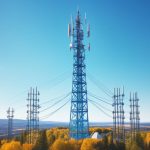Welcome to our comprehensive guide on fixed wireless networks! In this article, we will delve into the types and fundamentals of fixed wireless technology. Whether you’re looking for a reliable internet solution for your home or business or simply want to understand more about this innovative technology, we’ve got you covered.
Fixed wireless networking is an increasingly popular form of internet access, particularly in areas where traditional wired connections like fiber infrastructure are not readily available. It provides a viable solution for rural communities and underserved areas, bridging the digital divide and bringing high-speed internet to those who need it most.
In this guide, we will explore the workings of fixed wireless internet, its benefits, and how it compares to other internet solutions such as satellite internet and Wi-Fi. We will also discuss the exciting advancements in fixed wireless technology, including its integration with the latest cellular-wireless standard, 5G.
Whether you’re a homeowner, business owner, or IT professional, understanding the ins and outs of fixed wireless networks can empower you to make informed decisions about your internet connectivity options. So, let’s dive in and explore the fascinating world of fixed wireless!
What is Fixed Wireless?
Fixed wireless networking refers to the operation of wireless devices in fixed locations such as homes and offices. Unlike mobile wireless devices, fixed wireless devices derive their power from utility mains. Fixed wireless is the typical form of internet deployed in areas with no fiber internet infrastructure, mainly rural areas. Mobile or portable battery-powered wireless systems can serve as emergency backups for fixed systems in case of a power blackout or natural disaster.
Key Features of Fixed Wireless
- Providing internet access in fixed locations such as homes and offices
- Power source derived from utility mains
- Ideal solution for areas with no fiber internet infrastructure
- Potential use of mobile or portable battery-powered wireless systems as backup during emergencies
Fixed wireless networking refers to the operation of wireless devices in fixed locations such as homes and offices. Unlike mobile wireless devices, fixed wireless devices derive their power from utility mains.
Fixed wireless networks are designed to bring reliable and high-speed internet access to areas where traditional wired connections are not readily available. These networks are commonly deployed in rural and underserved areas, providing a cost-effective solution for internet connectivity. Unlike satellite internet, which requires a dish to receive signals from satellites, fixed wireless relies on towers and receivers installed on the user’s property, ensuring a more stable connection. In case of power outages or natural disasters, fixed wireless systems can be supplemented with mobile or portable battery-powered wireless systems as emergency backups.
How Does Fixed Wireless Internet Work?
Fixed wireless internet is broadcast from towers through airwaves to receivers that the service provider will have installed on the user’s property. The receiver needs to be within around 10 miles from the fixed wireless internet service provider’s tower for the connection to work. Fixed wireless broadband modems bypass the telephone system and offer internet access that is much faster than traditional wired connections. Fixed wireless internet provides numerous benefits:
- Flexibility: Fixed wireless allows for easy addition or relocation of subscribers without the need to modify the network infrastructure.
- Expanded Coverage: It brings reliable internet access to remote areas without the need for new cables or extensive infrastructure development.
- Broad Bandwidth: Fixed wireless offers a wide bandwidth without the limitations of wires or cables, delivering faster speeds for seamless online activities.
This technology is particularly advantageous in rural and underserved areas where fiber internet infrastructure is lacking. By utilizing wireless towers and receivers, fixed wireless internet bridges the connectivity gap and provides reliable and high-speed internet access to individuals and businesses.
With fixed wireless, users no longer have to rely solely on traditional wired connections. It offers a viable alternative that can deliver fast and dependable internet access in areas where wired connections may not be feasible or cost-effective. Additionally, fixed wireless internet has the capability to evolve alongside emerging technologies such as 5G, promising even greater bandwidth and connectivity options in the future.
Exploring the Types of Fixed Wireless Networks
Fixed wireless networks are a critical component of global connectivity solutions, offering an alternative to traditional wired broadband by utilizing radio waves for data transmission. Among the various types of fixed wireless networks, Fixed Wireless Access (FWA) stands out for its role in providing broadband internet access to homes and businesses. Here’s a closer look at FWA alongside other types of fixed wireless networks:
Fixed Wireless Access (FWA)
FWA is a key method for delivering high-speed internet services to end users in fixed locations, using base stations to communicate with receivers installed at the customer’s premises. It’s particularly effective in areas underserved by wired infrastructure, offering a cost-effective and rapid deployment alternative. With the advent of 5G technology, FWA’s potential has significantly expanded, promising enhanced speeds, lower latency, and greater capacity to support a surge in demand for wireless broadband services.
Point-to-Point (PtP) Networks
Point-to-Point networks are designed to connect two locations directly, using radio waves for dedicated communication. Ideal for linking two distant sites, PtP is favored for its high reliability and capacity, supporting a wide range of data, voice, and video services.
Point-to-Multipoint (PtMP) Networks
PtMP networks feature a central base station that wirelessly connects multiple remote sites or clients. This setup is scalable and efficient for distributing internet access across a broad area, making it suitable for both residential and business applications.
Mesh Networks
Mesh networks consist of nodes that cooperatively distribute data across the network. This topology enhances coverage and reliability by allowing data to reroute around obstacles or failures, making mesh networks adaptable to various environments, including challenging urban landscapes.
Cellular Networks for FWA
Cellular networks, traditionally associated with mobile communications, also facilitate FWA through LTE and emerging 5G technologies. These networks are increasingly leveraged for fixed internet access, offering competitive speeds and reliability.
FWA and other fixed wireless network types collectively represent a versatile and expanding field of connectivity solutions. By leveraging different technologies and configurations, they address diverse needs and challenges, from urban to rural internet access, underscoring the dynamic nature of wireless communication in bridging the digital divide and beyond.
Next, we will explore how fixed wireless compares to other forms of internet connectivity, such as satellite internet and Wi-Fi.
Fixed Wireless Internet vs. Satellite Internet vs. Wi-Fi
| Factors | Fixed Wireless Internet | Satellite Internet | Wi-Fi |
|---|---|---|---|
| Connection Method | Broadcast from towers to receivers on user’s property | Signals received from satellites in space via a dish on user’s property | Local wireless network connecting devices within a specific area |
| Signal Reliability | Less affected by weather conditions | Potential signal disruptions due to atmospheric interference | Subject to range limitations and interference from neighboring networks |
| Data Caps | Higher data caps available | Lower data caps due to bandwidth limitations | Dependent on the internet service provider’s plan |
| Latency | Lower latency for faster response times | Higher latency due to signal travel distance to satellites and back | Lower latency within a local area network |
As shown in the table above, fixed wireless internet offers advantages over satellite internet and Wi-Fi in terms of signal reliability, data caps, and latency. It provides a robust and reliable internet connection, making it suitable for various applications, including online gaming, video streaming, and remote work.
Now that you have a better understanding of how fixed wireless internet works and its advantages, let’s explore its relationship with 5G technology in the next section.
Fixed Wireless and 5G
Fixed wireless networking is greatly enhanced by the latest cellular-wireless standard, 5G. This advanced technology offers significant improvements in quality of service, increased bandwidth, and the utilization of software-defined WANs. With its promising capabilities, fixed 5G wireless is poised to replace traditional broadband internet, including Wi-Fi, in many applications.
Organizations that are expanding work-from-home options for employees will particularly benefit from fixed wireless and 5G. The combination of these technologies ensures reliable and high-bandwidth connections, essential for enterprise applications and seamless productivity.
“Fixed wireless is one of the top use cases for 5G, providing better connectivity options and meeting the growing demand for high-speed internet access.” – John Rogers, Tech Expert
As the reliance on remote work continues to increase, businesses and individuals are seeking fast and reliable internet connections. Fixed wireless, powered by 5G, holds the potential to fulfill these needs, revolutionizing the way we access the internet and enabling seamless connectivity in various industries.
Benefits of Fixed Wireless and 5G:
- Improved quality of service
- Higher bandwidth capacity
- Enhanced flexibility and scalability
- Reduced dependence on traditional wired connections
- Reliable and high-bandwidth connections for enterprise applications
With fixed wireless and 5G, the future of internet connectivity is poised to reach new heights, providing faster speeds and increased reliability. Embracing these technologies will empower businesses and individuals to thrive in the digital age.

Fixed Wireless vs. Satellite Internet
Fixed wireless internet and satellite internet are both options for internet access in rural and underserved areas. While both technologies offer connectivity solutions, there are significant differences between fixed wireless and satellite internet in terms of deployment, reliability, and performance.
Fixed wireless internet operates by transmitting signals from towers to receivers located on the user’s property. This technology utilizes airwaves to broadcast the signal, bypassing the need for physical cables. On the other hand, satellite internet relies on dishes to receive signals from satellites orbiting the Earth.
One of the key advantages of fixed wireless internet over satellite internet is its resistance to weather conditions. Satellite internet is susceptible to signal disruptions due to atmospheric interference, such as heavy rain or snow. In contrast, fixed wireless internet is less affected by weather changes, providing more reliable connectivity.
Another factor to consider is the data caps and latency. Fixed wireless internet generally offers higher data caps, allowing users to consume larger amounts of data without exceeding their plan limits. Additionally, fixed wireless internet tends to have lower latency, resulting in faster response times and better performance for applications like online gaming or video conferencing.
Here is a comparison table highlighting the key differences between fixed wireless and satellite internet:
| Fixed Wireless Internet | Satellite Internet | |
|---|---|---|
| Technology | Uses towers and airwaves | Relies on satellites in space |
| Weather Affected | Less affected by weather conditions | Susceptible to atmospheric interference |
| Data Caps | Higher data caps available | Lower data caps in general |
| Latency | Lower latency, suitable for real-time applications | Higher latency, may experience delays |
Based on these factors, fixed wireless internet may be a more favorable option for those seeking reliable and high-performance internet access in rural areas. While satellite internet provides connectivity in remote locations where physical infrastructure is limited, it may be prone to weather-related disruptions and have lower data capacity.
Overall, selecting the right internet solution depends on individual needs and specific circumstances. Evaluating factors such as reliability, performance, and data requirements will help determine whether fixed wireless or satellite internet is the most suitable choice.
Fixed Wireless vs. Wi-Fi
Wi-Fi and fixed wireless are not the same thing, although fixed wireless can be used to deliver internet connections to wireless routers or modems used for Wi-Fi. Wi-Fi uses the IEEE 802.11 standards to connect devices on a local area network (LAN) and transmit data via radio waves. Fixed wireless, on the other hand, refers to the operation of wireless devices in fixed locations and is typically used in areas with no fiber internet infrastructure. While fixed wireless can be used to provide internet access to Wi-Fi routers, it is not a replacement for Wi-Fi itself.
Comparison between Fixed Wireless and Wi-Fi
| Aspect | Fixed Wireless | Wi-Fi |
|---|---|---|
| Definition | Operation of wireless devices in fixed locations, used in areas without fiber internet infrastructure | Connects devices on a local area network (LAN) using IEEE 802.11 standards |
| Primary Use | Providing internet connections to fixed locations | Enabling wireless connectivity within a limited range |
| Infrastructure | Requires installation of towers and receivers for broadcasting internet signals | Relies on wireless routers or modems within a limited coverage area |
| Application | Used in rural areas or places with limited wired connectivity options | Used in homes, offices, and public spaces for local wireless networking |
| Performance | Offers high-speed and reliable internet access, ranging from 10 Mbps to Gigabit speeds | Provides wireless connectivity within a limited range, typically up to several hundred feet |
| Scalability | Suitable for expanding internet access to additional fixed locations without extensive infrastructure changes | Limited scalability based on the range and capacity of the wireless router or modem |
“While fixed wireless can be used to provide internet access to Wi-Fi routers, it is not a replacement for Wi-Fi itself.”
Illustration of a fixed wireless tower and a Wi-Fi router for visual reference.
Conclusion
Fixed wireless networks provide a reliable and high-speed internet access solution for areas where traditional wired connections are unavailable. This technology is particularly beneficial for rural and underserved areas, offering flexibility, scalability, and cost-effectiveness. With the emergence of 5G, fixed wireless technology is evolving, providing even greater bandwidth and connectivity options.
Compared to satellite internet and Wi-Fi, fixed wireless offers distinct advantages. It delivers a more stable and robust connection, less affected by weather conditions or atmospheric interference. Additionally, fixed wireless internet typically offers higher data caps and lower latency, making it suitable for applications that require fast and consistent connectivity like online gaming.
As a result, fixed wireless is increasingly becoming the preferred choice for individuals, businesses, and organizations seeking reliable and high-speed internet connections. Its ability to bridge the digital divide and bring fast internet access to rural and underserved areas makes it a valuable tool for enabling economic growth, educational opportunities, and access to essential online services.
FAQ
What is fixed wireless?
Fixed wireless networking refers to the operation of wireless devices in fixed locations such as homes and offices. It is the typical form of internet deployed in areas with no fiber internet infrastructure, mainly rural areas.
How does fixed wireless internet work?
Fixed wireless internet is broadcast from towers through airwaves to receivers that the service provider installs on the user’s property. The receiver needs to be within around 10 miles from the fixed wireless internet service provider’s tower for the connection to work. Fixed wireless broadband modems offer internet access that is much faster than traditional wired connections.
What are the benefits of fixed wireless internet?
Fixed wireless internet offers benefits such as flexibility in adding or moving subscribers without modifying the network infrastructure, bringing internet access to remote areas without the need for new cables, and a broad bandwidth without the limitations of wires or cables.
How does fixed wireless compare to satellite internet?
Fixed wireless internet and satellite internet are both options for internet access in rural and underserved areas. Fixed wireless internet uses towers to broadcast the signal to receivers on the user’s property, while satellite internet requires a dish to receive signals from satellites in space. Fixed wireless internet is less affected by weather conditions compared to satellite internet and generally offers higher data caps and lower latency.
What is the difference between fixed wireless and Wi-Fi?
Wi-Fi uses the IEEE 802.11 standards to connect devices on a local area network (LAN) and transmit data via radio waves. Fixed wireless, on the other hand, refers to the operation of wireless devices in fixed locations and is typically used in areas with no fiber internet infrastructure. While fixed wireless can be used to provide internet access to Wi-Fi routers, it is not a replacement for Wi-Fi itself.



















